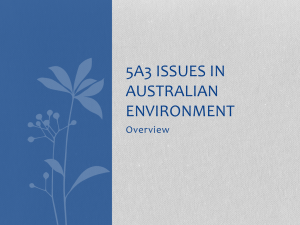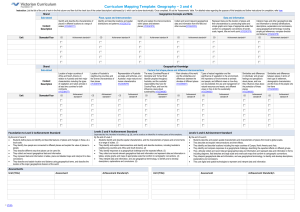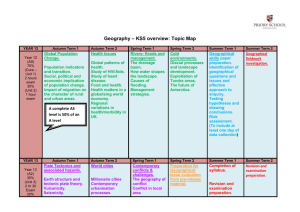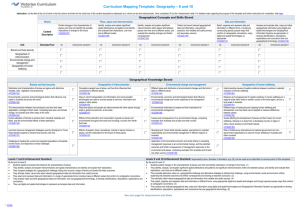Geography - 5Es
advertisement
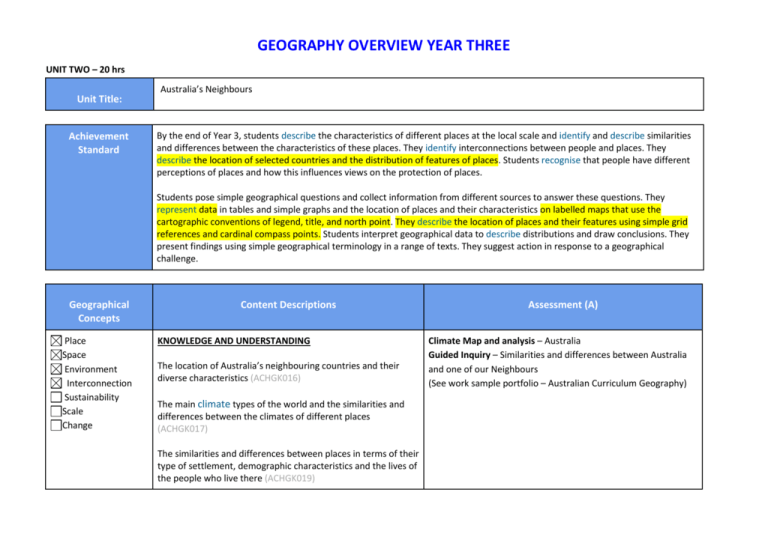
GEOGRAPHY OVERVIEW YEAR THREE UNIT TWO – 20 hrs Unit Title: Achievement Standard Australia’s Neighbours By the end of Year 3, students describe the characteristics of different places at the local scale and identify and describe similarities and differences between the characteristics of these places. They identify interconnections between people and places. They describe the location of selected countries and the distribution of features of places. Students recognise that people have different perceptions of places and how this influences views on the protection of places. Students pose simple geographical questions and collect information from different sources to answer these questions. They represent data in tables and simple graphs and the location of places and their characteristics on labelled maps that use the cartographic conventions of legend, title, and north point. They describe the location of places and their features using simple grid references and cardinal compass points. Students interpret geographical data to describe distributions and draw conclusions. They present findings using simple geographical terminology in a range of texts. They suggest action in response to a geographical challenge. Geographical Concepts Place Space Environment Interconnection Sustainability Scale Change Content Descriptions KNOWLEDGE AND UNDERSTANDING The location of Australia’s neighbouring countries and their diverse characteristics (ACHGK016) The main climate types of the world and the similarities and differences between the climates of different places (ACHGK017) The similarities and differences between places in terms of their type of settlement, demographic characteristics and the lives of the people who live there (ACHGK019) Assessment (A) Climate Map and analysis – Australia Guided Inquiry – Similarities and differences between Australia and one of our Neighbours (See work sample portfolio – Australian Curriculum Geography) GEOGRAPHICAL INQUIRY AND SKILLS Collect and record relevant geographical data and information, for example, by observing by interviewing, conducting surveys, measuring, or from sources such as maps, photographs, satellite images, the media and the internet (ACHGS020) Represent data by constructing tables and graphs (ACHGS021) Represent the location of places and their features by constructing large-scale maps that conform to cartographic conventions including scale, legend, title and north point, and describe their location using simple grid references, compass direction and distance (ACHGS022) Interpret geographical data to identify distributions and patterns and draw conclusions (ACHGS023) Present findings in a range of communication forms, for example, written, oral, digital, graphic, tabular, and visual, and use geographical terminology (ACHGS024) Learning Framework Cross Curricula Priorities General Capabilities Community Contributor Leader and Collaborator Catholic Ethos Aboriginal and Torres Strait Islander Histories and Cultures Literacy Critical and Creative Thinking Active Investigator Effective Communicator Social Emotional Learning Asia and Australia’s Engagement with Asia Numeracy Ethical Behaviour Designer and Creator Quality Producer Inclusive Education Sustainability Education Information and Communication Technology Personal and Social Competence Links to other LA’s Mathematics Create and interpret simple grid maps to show position and pathways (ACMMG065) Collect data, organise into categories and create displays using lists, tables, picture graphs and simple column graphs, with and without the use of digital technologies (ACMSP069) Interpret and compare data displays (ACMSP070) Science Use a range of methods including tables and simple column graphs to represent data and to identify patterns and trends (ACSIS057) English Use comprehension strategies to build literal and inferred meaning and begin to evaluate texts by drawing on a growing knowledge of context, text structures and language features (ACELY1680) Use software including word processing programs with growing speed and efficiency to construct and edit texts featuring visual, print and audio elements (ACELY1685) Learning and Teaching Strategies Week 1 Cross Curricular Priorities 2 3 4 5 Catholic Ethos Aboriginal and Torres Strait Islander Histories and Cultures General Capabilities Literacy Critical and Creative Thinking Engage ⇒ Explore ⇒ 6 7 Social Emotional Learning Asia and Australia’s Engagement with Asia Numeracy Ethical Behaviour Explain ⇒ ENGAGE 8 9 10 Inclusive Education Sustainability Education Information and Communication Technology Personal and Social Competence Elaborate ⇒ Evaluate Resources Introduce unit through the use of a passport. Discuss that we will be travelling to our neighbouring countries and learning Do an internet search to ‘ Create a about their people and environment. Discuss “What is a neighbour?” Discuss with students places they’ve been. Ask if they passport template’ to find an could name any neighbouring countries. Use KWL chart to record. activity suited to your students. Make their passport, decorating as required, ready for future lessons Geographical Language Passport, travelling, journey, neighbour, neighbouring Reflection Assessment Opportunities Diagnostic Assessment – were students able to name any of Australia’s neighbours? Week 1 Cross Curricular Priorities General Capabilities Engage ⇒ 2 3 4 5 Catholic Ethos Aboriginal and Torres Strait Islander Histories and Cultures 6 8 Social Emotional Learning Asia and Australia’s Engagement with Asia Literacy Critical and Creative Thinking Explore ⇒ 7 10 Inclusive Education Sustainability Education Information and Communication Technology Personal and Social Competence Numeracy Ethical Behaviour Explain ⇒ 9 Elaborate ⇒ EXPLORE Evaluate Resources Australia’s Neighbours: Use Google Maps – locate Australia. Use the zoom in and out to locate Australia’s neighbours. Describe the location of these countries using positional language such as: north of Australia is Papua New Guinea; to the east of Australia is New Zealand etc . Identify capital cities and major natural features of neighbouring countries – including New Zealand, Papua New Guinea, Indonesia, Pacific Island Nations and Timor-Leste. Click on Traffic – photos to identify features of these counties. Use the Tag on the left side to specify features to look for – eg. Mountains. Create a table of information about each of the countries discussed using the map. Identify the names of the regions our neigbours are part of – for example – Pacific Neighbours: Fiji, Papua New Guinea, New Zealand, Solomon Islands, Tonga, Cook Islands, Nauru, Vanuatu, Western Samoa; Northern Neighbours: Indonesia, Papua New Guinea, Timor-Leste, Singapore, Malaysia and Brunei Further Activities: “Primary Society and Environment: Book D” RIC Publications – pg 37, 38, 39 – Mapping our Near-North Neighbours. Geographical Language Google Maps Chart Paper Pens “Primary Society and Environment: Book D” RIC Publications Assessment Opportunities Neighbours, country names, capital city names, natural features EXPLORE Resources Climate Maps: Discuss the difference between weather and climate – weather contributes to the climate type. Focus on tropical, temperate, dry/arid and polar/arctic and the features of each. In groups create a collage to represent the different climate zones. Look at various climate maps of Australia and the world. http://www.bing.com/images/search?q=climate+zones+of+the+world&qpvt=climate+zones+of+the+world&FORM=IGRE#vie w=detail&id=B9A42F1A0DF464E6DAA2641EF5A16D27705A42AA&selectedIndex=3 http://www.bing.com/images/search?q=climate+zones+of+the+world&qpvt=climate+zones+of+the+world&FORM=IGRE#vie w=detail&id=5DAD5CC14E5CA52A37A61253CC6964DC4A1F4CCC&selectedIndex=6 http://www.bing.com/images/search?q=climate+zones+of+the+world&qpvt=climate+zones+of+the+world&FORM=IGRE#vie w=detail&id=6B4DF8F87178B06A12CAC5054A7648A3BAC2C3DB&selectedIndex=26 Use a blank map of the world to mark in the climate zones – revising the Equator and tropics (from year 2). Model to students the use of the BOLTS process for mapping conventions (as in unit 1) as well as using a legend to identify the zones. Pose questions to help the students to identify the distribution of climate zones in the world. What do you notice about the location of the hot zones and cold zones of the world? Provide images/photographs that show features of these zones – for example in National Geographic website – photography – nature & weather or use Google maps in satellite. Create a table to show features: Climate Zone Countries Weather Features Chart Paper Magazines Internet Scissors Glue Web links as listed Blank map of the world Photographs of various climate zones Complete assessment task 1 (appendix) Further Activities: Use the data for average temperature and average rainfall for Australia to create a graph – either using Microsoft Excel or hand drawn. http://www.australia.climatemps.com/ . Students will need an understanding of the term average. Geographical Language Climate zones, hot, cold, temperate, tropics, polar, arid, dry, countries, weather, features, equator, world, continents, average Assessment Opportunities Complete assessment Task 1 Reflection Week 1 Cross Curricular Priorities General Capabilities Engage ⇒ 2 3 4 5 6 7 Catholic Ethos Social Emotional Learning Aboriginal and Torres Strait Islander Histories Asia and Australia’s Engagement with and Cultures Asia Literacy Critical and Creative Thinking Explore ⇒ Numeracy Ethical Behaviour Explain ⇒ 8 9 10 Inclusive Education Sustainability Education Information and Communication Technology Personal and Social Competence Elaborate ⇒ EXPLAIN Evaluate Resources Journey to Australia’s Neighbours: Introduce group task to students. Explain that they need to use their passport to travel to each of Australia’s near neighbours that have been identified. In order to complete this task, they must find important information about the country and write it in the relevant place on the passport. They will receive the country’s stamp once the information is completed and corrected. Students must travel to all of these countries in the next couple of weeks. Teacher will provide web links, video clips, travel brochures, books and any other materials to assist in the gathering of this information. Further Activities: “Primary Society and Environment: Book D” – Australia’s Neighbours Unit – pg 30 – 54 Model the construction of a Venn Diagram using information gathered (will need this for assessment task) Web links, video clips, travel brochures, books on the countries identified Geographical Language Assessment Opportunities Climate zones, hot, cold, temperate, tropics, polar, arid, dry, countries, weather, features, equator, world, continents, brochure Reflection Week 1 Cross Curricular Priorities General Capabilities Engage ⇒ 2 3 4 5 6 7 Catholic Ethos Social Emotional Learning Aboriginal and Torres Strait Islander Histories Asia and Australia’s Engagement with and Cultures Asia Literacy Critical and Creative Thinking Explore ⇒ Numeracy Ethical Behaviour Explain ⇒ 8 9 10 Inclusive Education Sustainability Education Information and Communication Technology Personal and Social Competence Elaborate ⇒ ELABORATE Evaluate Resources Guided Inquiry After completion of Passports, students use their compiled information to complete assessment task. Go through task sheet and criteria sheet with students Geographical Language See Assessment Task sheet Assessment Opportunities Completion of Assessment Task 2 Reflection Planning for Differently Abled Students Student/s Different Ability Australian Curriculum Content Descriptions being addressed Learning and Teaching Strategies Assessment Strategies Assessment Task 1 Student Name: Year Level: 3 Name of Task: Mapping Australia and its Neighbours Teacher: Learning Area/s: Geography Assessed By: Date Commenced: Date Due: Type of Task: Oral Written Other Task Conditions: Individual Pair Group Work In Class Homework Other Opportunity to Access: Books Notes Library Technology Assessed By: Self Peer Other Teacher Task Description Construct a map showing the distribution of climate types in Australia and write a paragraph to compare two climate zones. Procedure (You will) 1. Construct a climate map of Australia (using ICT or hand drawn) 2. Identify at least one place within one climate zone and label on the map 3. Write a short paragraph on what it would be like to live in a climate that’s different to your own Resources Computers, atlases GEOGRAPHY ASSESSMENT TASK 1 CLIMATE MAPS Achievement Standards A B C D E Geographical Knowledge and Understanding Considered identification and explanation of: *the characteristics of different places at the local scale *similarities and differences between the characteristics of places Identification and explanation of: * the characteristics of different places at the local scale *similarities and differences between the characteristics of places Identification and description of: *the characteristics of different places at the local scale *similarities and differences between the characteristics of places Partial description of: *the characteristics of different places at the local scale *similarities and differences between the characteristics of places Statements about: *the characteristics of different places at the local scale *similarities and differences between the characteristics of places Communicating Clear and purposeful communication of findings in a range of texts that: Effective communication of findings in a range of texts that: Communication of findings using geographical terminology in a range of texts that: Narrow communication of findings, using simple geographical terminology in a range of texts that: *represent the location of a range of places on labeled maps that use the cartographic conventions of legend, title and north point. *represent the location of a range of places on labeled maps that use the cartographic conventions of legend, title and north point. Fragmented communication of findings using provided geographical terminology in a range of texts that: *represent the location of a range of places on labeled maps that use the cartographic conventions of legend, title and north point. *represent the location of a range of places on labeled maps that use the cartographic conventions of legend, title and north point. *represent the location of a range of places on labeled maps that use the cartographic conventions of legend, title and north point. Geography Assessment Task 2 Student Name: Year Level: 3 Name of Task: Guided Inquiry – Similarities and differences between Australia and one of its neighbours Teacher: Learning Area/s: Geography Assessed By: Date Commenced: Date Due: Type of Task: Oral Written Other Task Conditions: Individual Pair Group Work In Class Homework Other Opportunity to Access: Books Notes Library Technology Assessed By: Self Peer Other Teacher Task Description You are to choose 2 locations to investigate and compare their similarities and differences. Procedure (You will) 1. Choose two places from: Jakarta Port Moresby Wellington Honiara Dili 2. Interpret the climate graph given, as well as maps of the Asia/Pacific region and the information collected throughout the term to answer questions found on the assessment worksheet. 3. Develop at least 3 geographical questions about the countries of the places chosen. 4. Conduct research to answer these questions and record your answers in the space provided. 5. Represent your findings in a Venn diagram to show the similarities and differences between the two places. 6. Write a paragraph explaining these similarities and differences. Resources Climate graphs for cities Maps, internet, computers Assessment worksheets CLIMATE GRAPHS FOR LOCATIONS Average Temperature - Port Moresby - Papua New Guinea 28.5 28 27.5 27 temp° 26.5 26 25.5 25 Jan Feb Mar Apr May Jun Jul Aug Sep Oct Nov Dec Average Rainfall - Port Moresby Papua New Guinea 40 35 30 25 20 cm 15 10 5 0 Jan Feb Mar Apr May Jun Jul Aug Sep Oct Nov Dec Average Temperature - Dili - TimorLeste 28.5 28 27.5 27 temp° 26.5 26 25.5 25 Jan Feb Mar Apr May Jun Jul Aug Sep Oct Nov Dec Average Rainfall - Dili - Timor-Leste 40 35 30 25 20 cm 15 10 5 0 Jan Feb Mar Apr May Jun Jul Aug Sep Oct Nov Dec Average Temperature - Jakarta Indonesia 28.5 28 27.5 27 temp° 26.5 26 25.5 25 Jan Feb Mar Apr May Jun Jul Aug Sep Oct Nov Dec Average Rainfall - Jakarta - Indonesia 40 35 30 25 20 cm 15 10 5 0 Jan Feb Mar Apr May Jun Jul Aug Sep Oct Nov Dec Average Temperature - Wellington New Zealand 28.5 28 27.5 27 temp° 26.5 26 25.5 25 Jan Feb Mar Apr May Jun Jul Aug Sep Oct Nov Dec Average Rainfall - Wellington - New Zealand 40 35 30 25 20 cm 15 10 5 0 Jan Feb Mar Apr May Jun Jul Aug Sep Oct Nov Dec Average Temperature - Honiara Solomon Islands 28.5 28 27.5 27 temp° 26.5 26 25.5 25 Jan Feb Mar Apr May Jun Jul Aug Sep Oct Nov Dec Average Rainfall - Honiara - Solomon Islands 40 35 30 25 20 cm 15 10 5 0 Jan Feb Mar Apr May Jun Jul Aug Sep Oct Nov Dec ASSESSMENT WORKSHEET Interpreting Climate Graphs Place 1 Questions Where is the place located in relation to Australia? Where is the place located in relation to the Tropic of Capricorn? Where is the place located in relation to the Equator? What is the hottest month? What is the average temperature in the hottest month? What is the coldest month? What is the average temperature in the coldest month? What is the wettest month? What is the driest month? What is the average rainfall of the wettest month? What is the average rainfall of the driest month? Place 2 ASSESSMENT WORKSHEET Country Investigation Country 1 Your questions to investigate Country 2 SIMILARITIES AND DIFFERENCES BETWEEN …………………………………….. AND …………………………………….. GEOGRAPHY ASSESSMENT TASK 2 GUIDED INQUIRY – SIMILARITITIES AND DIFFERENCES BETWEEN AUSTRALIA AND ITS NEIGHBOURS Achievement Standard A Geographical Knowledge Considered identification and Understanding and explanation of: *the characteristics of different places at the local scale *similarities and differences between the characteristics of places *the location of selected countries and the distribution of features of places Questioning and Development of a Researching geographical inquiry that includes: *logical and interrelated geographical questions *a collection of information from a range of valid sources to answer questions Communicating Clear and purposeful communication of findings in a range of texts that: *describe the location of a range of places and their features using cardinal points Overall Result B C D E Identification and explanation of: * the characteristics of different places at the local scale *similarities and differences between the characteristics of places *the location of selected countries and the distribution of features of places Development of a geographical inquiry that includes: *logical geographical questions *a collection of information from a range of sources to answer questions Effective communication of findings in a range of texts that: * describe the location of a range of places and their features using cardinal points Identification and description of: *the characteristics of different places at the local scale *similarities and differences between the characteristics of places *the location of selected countries and the distribution of features of places Development of a geographical inquiry that includes: *relevant geographical questions *a collection of information from different sources to answer questions Communication of findings using geographical terminology in a range of texts that: * describe the location of a range of places and their features using cardinal points Partial description of: *the characteristics of different places at the local scale *similarities and differences between the characteristics of places *the location of selected countries and the distribution of features of places Statements about: *the characteristics of different places at the local scale *similarities and differences between the characteristics of places *the location of selected countries and the distribution of features of places Development of a geographical inquiry that includes: *simple geographical questions *a collection of information from a narrow range of sources to answer questions Narrow communication of findings, using simple geographical terminology in a range of texts that: * describe the location of a range of places and their features using cardinal points Development of a geographical inquiry that includes: *use of provided geographical questions *a collection of information from supplied sources Fragmented communication of findings using provided geographical terminology in a range of texts that: * describe the location of a range of places and their features using cardinal points

